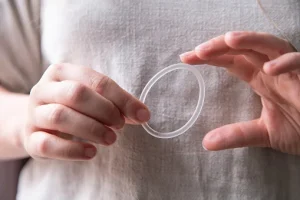
How to Use Birth Control Rings: Learn the Pros and Cons
The vaginal ring is inserted into the vagina to prevent pregnancy. It is soft and flexible. Learn how to insert a vaginal ring during sex or not.
Over the years, the immune system has transformed. People have turned to a variety of birth control methods to prevent pregnancy, from pills to condoms to special products. People also use vaginal rings, which are thin, flexible rings that are inserted into the vagina. Once released, it releases hormones for about three weeks. It’s an easy-to-use birth control method that has benefits and side effects.
What is a vaginal ring?
A vaginal ring is a small, flexible, round device used as a birth control method. It is made of plastic and is designed to be inserted into the vagina and release hormones to prevent pregnancy. The ring usually releases a combination of estrogen and progesterone, similar to the ingredients in birth control pills. The vaginal ring is usually worn for three weeks, then removed for one week during menstruation, after which a new ring is inserted.
The vaginal ring works by releasing a steady, low-dose stream of hormones (mostly estrogen and progesterone) through the walls of the vagina and into the bloodstream. The hormones prevent pregnancy by:
- Hormones stop the ovaries from releasing an egg each month. The progesterone in the
ring thickens the mucus in the cervix, making it harder for sperm to enter the uterus and reach an egg (if an egg is released). - The hormones also damage the lining of the uterus, making it less likely that a fertilized egg will implant and grow.
- According to the UK’s National Health Service, vaginal rings are more than 99% effective in preventing pregnancy when used correctly.
What types of vaginal rings are there?
There are two types of vaginal rings used for contraception:
1. Etonogestrel/ethinyl estradiol ring
The largest known and used vaginal ring, it is flexible, transparent, and about 2 inches in diameter. It is usually inserted into the vagina for three weeks and removed for one week during menstruation. After a one-week rest, a new ring is inserted into the vagina. It secretes estrogen (ethinyl estradiol) and progestin (etonogestrel) to prevent pregnancy.
2. Cyprogesterone acetate/ethinyl estradiol ring
This is a vaginal ring that can be used for up to one year. The ring is made of silicone and is slightly larger in diameter than the etonogestrel/ethinyl estradiol ring. The reusable ring is worn for three weeks and removed for one week when your period starts. After a week of rest, reinsert the same ring. This cycle can be repeated for 13 cycles (one year). It secretes estrogen (ethinyl estradiol) and progesterone (progesterone acetate).
How to insert the ring into your vagina?
To ensure your genital ring is working properly, please follow these steps:
- Before inserting the ring, make sure your hands are clean to avoid contamination.
- Find a comfortable position, such as standing on one leg, lying down, or squatting.
- Press the ring between your thumb and index finger to tighten it. Gently insert the ring into your vagina, pushing upwards until it is in the correct, comfortable position.
- It’s important to insert the ring on the same day of the week as the previous one to ensure good protection. If you delay reinserting the ring after the seven-day break, its effectiveness will decrease and you will need to use a birth control method such as a condom for the first seven days after repeating.
Can I have sex with a vaginal ring?
Yes, you can have sex with a vaginal ring. The birth control device is designed to stay in place even during intercourse, so there’s no need to remove it. Most women don’t feel the vaginal ring during intercourse. It’s soft, flexible, and sits high enough in the vagina that it’s not usually associated with sex. Some men can feel the ring, but most of the time it is a slight sensation.
Here are some steps you can take if you experience discomfort:
- Gently push the ring into your vagina to reduce sensation.
- If you remove the ring from your genital area during intercourse, you must reinsert it within three hours for it to be effective. Use birth control if you forget to reinsert it within three hours.
What are vaginal ring side effects?
Vaginal ring side effects include headache, nausea, and vomiting, according to a 2023 study published in the journal Advances in Therapeutics in Reproductive Health. Women may also experience yeast infections, abdominal pain, dysmenorrhea or menstrual pain, breast pain, irregular menstrual periods and vaginal irritation, according to the U.S. Food and Drug Administration.
Any woman who wears a ring can experience these side effects. However, women who cannot control their blood pressure should not use the ring because of the risk of increased blood pressure.
The genital ring is a good form of birth control, but be sure to remember when to put it back in your vagina. It’s flexible and soft and can be worn during sex.


